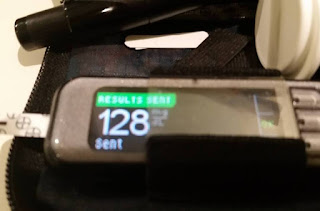In my opinion, and that of my health care team, unless the food contains poison I can eat
*almost anything, with some exceptions:
- *Celiac Disease: being gluten free places s a lot of restrictions on what I can eat and where I can eat.
- Type 1 Diabetes: places restrictions on when I can eat, depending on my blood sugar and insulin dosing.
- high blood sugar usually isn’t the best time to eat a donut, or sometimes anything at all depending on how high it is.
- low blood sugar mandates I eat something as soon as possible to bring blood glucose levels back in range.
Carbs are not my enemy. Food is not my enemy. Diabetes is my enemy. My personality has always been that if I really want something, I will figure
out how to do it. My relationship with
food is the same way.
I eat cereal. I eat Chinese food, and pizza, and donuts, and Tater Tots, and grapes, and so on. The only things I
don’t eat are foods containing gluten, bananas, and peppers.
How do I do it? I’d like to say the answer is simple, but it
really isn’t. I watch, observe, and learn. I watch and observe how my body
reacts to different foods, by testing my blood sugar frequently and with the use of continuous glucose monitoring (CGM) technology.
What I've learned:
- I've learned with the help of my MiniMed530G with Enlite (insulin pump and continuous glucose monitor) that bolusing at least 20 minutes before a meal with carbs helps. A lot.
- I've learned that when my blood sugar is over 160, it often takes a bit more time for my insulin to start working.
- I’ve learned how helpful the dual wave bolus feature on my insulin pump can be:
- The dual wave bolus allows you to split the total amount of insulin delivering some as soon as you start it, and the rest at a time frame you've set. How much you do, and how long you set the dual wave basal is trial and error. I started with 50% up front, then 50% an hour later then tweaked it from there.
- I've learned to pay attention to portion size also plays into this, as well as reading labels. I've learned that by paying attention to these portion size (and ingredients) when at home in a controlled setting it's a good starting point when I'm out.
It takes time and practice and isn’t an exact
science but it is possible.
Bon appetite!
- If you don’t have a CGM, it might mean more finger sticks than without CGM but it is possible.
- If you aren't on an insulin pump, or your's doesn't have a dual wave bolus option you can still do this manually - perhaps with the help of a timer so you don't forget to do the second bolus.
Bon appetite!
 |
| This picture is my blood sugar reading 2 hours after Chinese food for dinner. |
No comments:
Post a Comment